What is silver solder?
Silver solder is a special matter and requires special attention. The fact is that it is excellent for so-called step soldering, which refers to modern technologies for working with metals.
Some silver alloys can withstand very high temperatures - up to 600°C. It is this property that explains the high quality of soldering with such alloys.
Pure silver solder is rare. First of all, it's expensive. It is much cheaper and more effective to use its alloys with other metals, this is called silver-based solder. They most often contain cadmium, nickel, copper and zinc - excellent companions.
Pure silver solders are, of course, used, but only in jewelry, which is understandable.
Certificate for soft solders.
The properties of alloys depend primarily on the proportion of silver. If, for example, its content is above 50%, the alloy becomes ductile and resistant to significant loads. All possible options for silver alloys are set out in a special standard - this is GOST 19738-74 “Silver solders”.
An excellent option for saving money is home production of silver alloy for soldering with your own hands, which we will also analyze.
Average percentage of silver
Silver solder grade PSR 40 forms seams with good strength and ductility. It is recommended to use it for working with moving parts. After hardening, the connection can be deformed without compromising its integrity and strength.
The low melting point allows you to work at home. Copper-nickel, stainless, heat-resistant alloys, bronze, brass, and kovar are suitable for soldering with the specified silver solder.
The composition of PSR-45 allows you to firmly solder thick joints (up to 3 mm inclusive). The seams withstand shock, vibration, the influence of an oxidizing environment, and do not form cracks.
The result is largely due to the fact that the molten silver solder well envelops the working area. The alloy is used for soldering parts made of copper, nickel, steel, and bronze.
Physicochemical characteristics
In such alloys, silver is not always the main element. It is, for example, extremely popular when soldering stainless steel or other complex metals. Everyone knows the rule - the higher the silver percentage in the solder, the more ductile and stronger the connection is when soldering.
In addition, the melting point of silver solder with a high proportion of base metal allows greater freedom in choosing the temperature range in the use of the finished product.
One of the most common silver solder compositions is as follows:
- silver – 30%;
- copper – 20%;
- zinc – 16%;
- cadmium – 33%
This composition contains cadmium, which means the alloy is quite brittle. This silver solder is used in soldering products that will not be subject to any vibrations.
If you increase the proportion of soldering silver above 50%, you will get a mixture of metals with high fluidity and excellent resistance to later stress.
Varieties
Silver-containing solders are divided into groups based on the proportion of silver they contain .
Compositions containing up to 40% base metal are used when joining parts made of steel and non-ferrous alloys. The strength characteristics of this material make it possible to solder workpieces no thicker than 3 mm.
Solders containing 40-60% Ag are suitable for soldering copper, nickel and steel in structures subject to heavy constant and variable loads.
The high content of the base metal allows the use of silver solder for critical high-load connections, contacts in electrical engineering and electronics, band saw blades and the like.
How to choose the right solder?
It’s not so easy to choose the most suitable option from a huge number of different alloys. Clearly, if vibration resistance and high shock resistance are your top priorities, you should opt for high-silver options.
The same choice applies to working with refrigeration and climate control equipment.
Partner metals behave differently. If, for example, lead should never be added to the alloy when working with products that are resistant to high temperatures, then copper behaves perfectly under such conditions and is an excellent partner for the main components.
If the alloy contains cadmium, then there is increased brittleness - which is why it is a rare element in silver-based solders.
But phosphorus is a popular additive due to its ability to reduce the melting point, which is useful when working with stainless steel, aluminum and other complex metals.
How and with what help to solder silver?
Before you decide to solder parts of a silver product yourself, you need to understand the physical and chemical properties of the noble metal. The melting point of silver is 960 degrees. This is an average for the various metals used to make jewelry.
The melting point depends on how much pure silver is contained in the alloy. To ensure high-quality soldering, you need to carefully approach the choice of silver solder.
It is a strong solder joint and is used for soldering both non-ferrous and ferrous metals, as well as various alloys. For ease of use, all solders are subject to markings, including an alphanumeric set. The digital indicator determines the amount of silver in the solder as a percentage.
Any seam soldered with solder is resistant to corrosion, does not deform, and is durable. The most important factor of the above is anti-corrosion. To ensure that this point is observed, you should choose solders that have a high content of pure silver.
If it is impossible to purchase solder at special retail outlets, you can make it yourself. The most common and high-quality composition, which includes:
All components are melted in a muffle furnace. After melting, the mixture is poured onto a substrate and passed through a machine to produce sheets of the desired thickness. For soldering, sheets of 1-3 mm are used. Strips of the required length are cut from them.
Read also: Why do you need a relay regulator?
DIY silver solder
The word "prepare" is quite an appropriate expression in this section because silver solder can be prepared in many ways, including the old technique. Let us immediately note that here you need practice to achieve perfection.
GOST for silver solders.
The old recipe requires two coins: a copper nickel from 1962 and a fifty-kopeck coin from 1924, and additional metals, a gas burner for soldering silver and a spoon.
It starts like a fairy tale: we melt silver in a spoon. Then lower the copper coin and mix, rolling the spoon. The more patiently you roll the spoon, the better the mixing will be. After this, the solution is poured into a metal mold called “ingus” and rolled out again.
The alloy prepared in such a primitive way actually has very high qualities: it is pure sample No. 900.
An important factor in the quality of preparation is fresh flux. The flame in the burner must be monitored very carefully: it should be soft, and a not very hot fire should resemble a broom in outline. In this case, the seam will turn out to be of truly high quality.
To repair products, solder is made light in the following composition:
- silver – 7 parts;
- brass – 2.8 parts;
- zinc – 0.35 parts.
We stock up on the following materials for work:
- spoon;
- soldering torch;
- sandpaper or sandpaper;
- scissors, folds, scales;
- mixing spatula;
- borax for adding to the finished melt.
You need to work with brass first - clean it from the oxide film. Melt silver with hallmark No. 999 in a spoon, add brass and mix well right in the spoon. After complete melting, add zinc.
You can add zinc in its pure form, or in an alloy with brass or copper. Zinc is often added by wrapping it in foil. We begin to roll the composition. We cut the finished rolled sheet with scissors.
What fluxes are suitable?
To create a strong connection, it is necessary to properly prepare the surfaces for soldering. To do this, they are cleaned mechanically. Silver solder is used with soldering flux - a liquid or paste that destroys the oxide film and facilitates soldering, increasing the fluidity of the melt.
Borax powder is widely used. It is diluted in a small amount of water, heated and stirred until solder paste is formed.
With this composition you can solder from 490 to 910°C
Ready-made soldering fluids and pastes are also widely available on the market. It is better for a novice master to use purchased materials. Making your own fluxes requires skills in handling strong chemicals.
Melting solder
If you decide to do without old recipes, stock up on these materials:
- container with water;
- wood mixture with coal;
- borax;
- crucible and iron hook.
Solder composition and melting point.
We melt metals in a crucible, which must be placed in a forge or heated with a blowtorch. During melting, be sure to add borax. It is important to know and follow a clear sequence of the process. The main thing is to melt refractory metals first, and only then fusible ones.
Liquid metals are constantly stirred in the crucible with a hook or wooden stick. It is better to divide the process into two stages. The crucible with molten metals is removed from the furnace, and the metal is combined with water. The resulting small drops of metal are dried and melted again, adding borax.
After final melting, pour the solder into the mold. When it hardens, roll it into strips.
The most important part of the silver soldering process at home is the transition of the alloy from liquid to solid state. First, the mixture is melted and then cast into ingus.
The preparation of the spoon is as follows: a rectangular-shaped cardboard is placed on its bottom, and a plate is placed on top of it so that its edges wrap around the edges of the spoon. Cardboard sheets are carefully crimped to form a concave-shaped bed.
Sorting of the charge is carried out on special jewelry scales, scrap silver of different samples is checked and weighed: 916 and 875, pure silver, metal, borax. The charge is divided into equal piles of approximately twenty grams, it is cleaned using a magnet to remove impurities of iron and steel.
Scrap with purity 875 is mixed with the remaining parts. Borax acts as a flux.
The proportion of silver sample No. 875 and copper is exactly 4:1 (three copper nickels and one fifty kopecks), borax is added at the rate of one part per ten parts of the charge.
Ingus or another form is greased with wax and placed next to the burner. The fact is that the melt should under no circumstances cool down. Therefore, it is poured into well-heated ingus. The mold is then placed under cold water to cool. The cooled block is removed.
Technology for creating at home
Preparing solder for soldering silver with your own hands allows you to save significant amounts, but requires melting and foundry equipment and certain skills.
You can do it in the following sequence:
- chop scrap with metal scissors;
- grind the filler material;
- remove iron dust from them with a powerful magnet;
- use precise scales to weigh out 20 gram portions of the charge;
- add 10% borax and mix thoroughly;
- put the weighed portion into a melting spoon and heat with a burner until completely melted;
- warm up the casting mold, called “ingus”;
- pour a spoonful of melt into the ingus in one go;
- cool the mold under running water;
- knock the finished solder out of the mold.
During work, you should be careful, use personal protective equipment, a hood, and do not leave the burner unattended.
A few words about fluxes
The purpose of fluxes is to protect the soldering metal from the effects of oxides by isolating the soldering area from air. The most common composition of fluxes for repairs is a mixture of potash and borax in equal proportions; sometimes soda is used instead of potash.
To obtain powdered borax, you must first dry the aqueous solution of borax. It is better to do this on a regular gas stove in a porcelain evaporation container.
Once the solution turns into crystals, they need to be ground to a powder. Flux must be removed after soldering with a weak heated acid solution.
Medium melting alloys
Silver solder has unique qualities:
- highest strength;
- resistance to corrosion and in aggressive environments;
- low melting point;
- high thermal conductivity.
In addition, it perfectly fills all the gaps between soldered surfaces and fits perfectly on any metal surface.
Making silver solder is easy, creative and very fun. And if you take into account the significant cost savings, then silver soldering is a method that is worth learning.
Soldering process
If you have the appropriate tools, you can carry out soldering yourself. The most difficulties arise when working with stainless steel. The recommendations are as follows:
- To begin with, the surface is cleaned from various contaminants; any mechanical method can be used. Most often, paint and dirt are removed with a brush, after which the surface is degreased using a special composition.
- Selected flux is laid out on the future soldering area. Application technology largely depends on what material is used. The flux must be distributed evenly, otherwise the quality of the connection may be poor.
- To process a large area, a special torch is used to heat the metal to the required temperature. The first sign that the material is ready for soldering is a change in its temperature.
- After reaching the required state of the workpiece, the selected solder is supplied. It should be spread over the surface in an even layer.
- The entire seam is passed from start to finish. A little time is given for the material to cool, after which the workpiece is heated a little more to gradually reduce the temperature.
If the connection area is small, then you can use a small soldering iron. In this case, there is no need to preheat the base.











